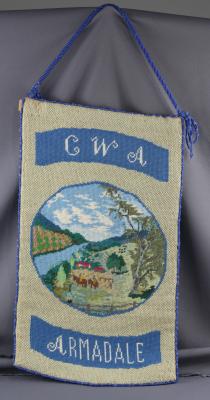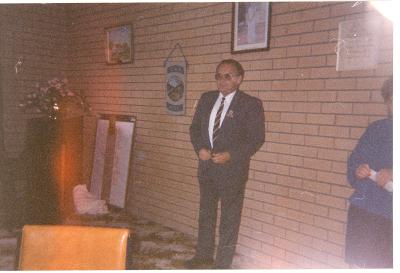SIGN ADVERTISING NARROGIN INNE
1933 - 1958Large shield roughly heart shaped with a straight top and the sides at right angle to it and parallel with each other tapering to a point at the bottom.
Old English lettering in gold with black shadow on a base coat of what was once green on both sides. Text same on both sides [GAYNOR'S / YE OLDE / NARROGIN / INNE]
In 1900 the Narrogin Inn changed its name to 'Ye Old Narrogin Inne'.
This name was kept when in 1938 the Narrogin Inn was refurbished by William 'Bill' Gaynor. This sign was hung at the front of the building which is located at the junction of the Albany and South West highway.
Originally built in 1856 by Thomas Saw. He and his father-in-law then applied for a wayside inn license. The hotel soon became a popular staging post for travellers, stage coasts and the mail cart between Albany and Perth. The hotel was soon known as Ye Old Narrogin Inn. Fresh horses were available at the near by Paradise Farm. Between 1867 and 1874 the licence was leased to William Foster. Foster in 1874 was murdered at the Inn by John Gill (alias James Goodall) who was working at the Inn as a cook. The licence returned to Thomas Saw
In 1894 the Inn hosted the first meeting of the recently formed Kelmscott Roads Board.
In 1910 Kate Wilkinson purchased the inn and ran it till 1919 when Maude Mary Kerrigan took over the lease. In 1926 James Samuel Devlin a hotelier from Perth took up the lease. During this time the hotel became a popular spot for honeymooners.
In 1933 the Narrogin Inn was acquired by Margaret and William Gaynor. That same year the Duke of Gloucester stopped at the Inn and possibly stayed there on his way to Fairbridge Farm.
1934 John Spencer Kerbey leased the Inn. In 1941 and 1942 his wife Myra was the licensee. In 1947 Margaret Gaynor died and the title passed onto her husband who later died in 1958.
The owners of the Inn after William Gaynor was Myra Kerbey. In following owners were A J Glanville & Company Pty Ltd, 1966-67. The Swan Brewery Company 1967-1977. Takee Pty Ltd 1977-1982. TVW Enterprise Ltd 1982-1993 and Paliker Holdings 1993-1999.
The Inn has undergone several renovations. In 1937 the original hotel was replaced with an inter-war old English style building, built by the Todd Brothers and designed by the architects Eales, Cohen and Fitzhardinge. An 1890 extension though was retained for accommodation. In the 1960s a single story bottle shop was added
In 1979-80 the Inn underwent further refurbishment as part of the Pioneer Village development. In 1999 the architectural firm Erwin Biemel & Associates was engaged to modernise and upgrade the facilities.
The place has aesthetic value as an outstanding and rare example of a building constructed in the inter-war Old English style and exhibits detailing consistent with this style including its picturesque asymmetrical form, warm-coloured face-brickwork and distinctive timber panelling.
With its distinctive building form and prominent location near the intersection of Albany Highway and South West Highway, the place is a well-known landmark in Armadale.
The place is one of a number of similar buildings dating from the inter-war and post war period which are located on the east side of the South West Highway in central Armadale.
The place is situated on a site at the junction of Albany Highway and South West Highway, which has functioned continuously as the site of a hotel since at least 1856. The original inn on the site served mail and passenger coach services to Albany and Bunbury prior to the opening of the Great Southern (1899) and South West (1893) railways.
The Duke of Gloucester is believed to have stopped at the place on his way to visit Fairbridge Farm in 1933.
The place was closely associated with local farmer and businessman, Thomas saw, who was responsible for the 1856 building and the first wayside inn licence for the place, and who owned the place until 1910.
Along with the nearby Muckross Tearooms and Kate Wilkinson Cottage, the place is one of a number of buildings dating from the early 20th century associated with Kate Wilkinson a well-known and respected local businesswoman.
The place is of significance to the local community as one of the early sopping places for coaches, and as a venue for socialisation by the local community and travellers from 1856 to present.
The place is valued by the community as a long-standing social venue and landmark.
Details
Details
This object is part of a collection that represents the commercial history of the City of Armadale. It represents the many different businesses that have operated in the local area and how those businesses have evolved over time. Businesses play an important role within a community, they provide wanted and needed goods and services, employment, income and opportunities to the local community. They can also operate as important social connectors, places where people gathered and engaged with other members of the community.
City of Armadale - History House
City of Armadale - History House
Other items from City of Armadale - History House
- BOOK - PLANNING MEAT RATION MEALS
- NUMBER PLATE 123 AK CITY LIVING COUNTRY STYLE
- COUNTRY WOMEN'S ASSOCIATION DIAMOND JUBILEE MEMORIAL EMBROIDERED PLAQUE
- CWA MOTTO FRAMED
- IRENE LINKLATER MEMORIAL
- CWA SIGN
- SHIELD - SPEAKER OF THE YEAR (CWA)
- CWA ARMADALE BRANCH SIXTIETH BIRTHDAY SHIELD
- PLATE CWA STATE DRAMA COMMITTEE VERSE READING AWARD
- VISITORS BOOK
- PENNANT - TAPESTRY CWA
- PHOTOGRAPH OF IAN BLACKBURN IN CWA ROOM



